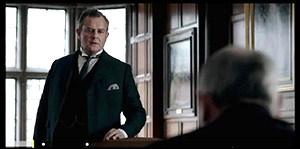Courtesy of Pam Martens.

Downton Abbey's Earl of Grantham Getting the News That He Has Lost the Bulk of His Wife's Inheritance On a Railway Stock
If you were among the breathless throng of PBS viewers awaiting the first episode of the third season of Downton Abbey last Sunday evening, and you are a cautious investor, you were no doubt horrified at how the Earl of Grantham had tossed his wife’s fortune and the financial security of his family into a solitary stock now set to file bankruptcy.
Downton Abbey is the British television series written by Julian Fellowes that has become an international sensation. The first season began in the years leading up to World War I. We have now moved along to 1920 in the fictional country estate, Downton Abbey, of the Crawley family, headed by the Earl and Countess of Grantham.
This should be the most joyful time in the Earl of Grantham’s life. His palatial home, which had been turned into a military hospital during the war has now been restored to normalcy and a beautiful wedding is about to take place for his beloved daughter, Mary.
But then the message comes for the Earl to travel to London to receive grave news from his financial advisor. The Earl has put the bulk of his American wife’s fortune, left to her by her father, in the Canadian Grand Trunk Line – a railway stock.
As the Earl learns “almost all” the money has been lost, he asks his advisor why so much money was invested. His advisor reminds him that it was the Earl himself who insisted. The Earl retorts: “It wasn’t just me, everyone said we couldn’t lose.”
…



